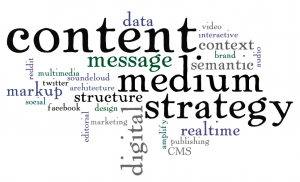We all like clarity — bright dividing lines that indicate what we’re accountable for and where we should fear to tread. Back in the old days of newspaper publishing, roles were clear: the journalists wrote the copy, the photographers snapped the images (but not too many of them for a Serious Publication), and the business side handled the unseemly aspects of the work, like advertising and circulation management. For the most part, people knew how to swim in their own lane to achieve a clear result.
 But along came the internet, and all the intricacies of online publishing emerged once people realized the new world wasn’t just a Quark-to-HTML export function. Along with disrupting who could capture and report the news (with highly variable quality), the internet has also made murky the clear dividing lines dictating where the content drives use of the medium, and where new opportunities in the medium drive the content.
But along came the internet, and all the intricacies of online publishing emerged once people realized the new world wasn’t just a Quark-to-HTML export function. Along with disrupting who could capture and report the news (with highly variable quality), the internet has also made murky the clear dividing lines dictating where the content drives use of the medium, and where new opportunities in the medium drive the content.
Two recent articles highlight different aspects of this complexity:
Om Malik weighs in with a terrific piece on the opportunities for journalism in a post-Snow Fall world. Lauding The New York Times for its innovation, he points out:
There is a failure in the media business to understand that the medium and the content are intertwined much like those lovers on the walls of Ajanta and Ellora caves. … Now take all of that as context and then understand why I keep harping on the point that Snow Fall-type products are a brand new media, a whole new style of storytelling and a model for 21st-century journalism
There is a remarkable opportunity here for online publishers ready to adopt a forward-thinking digital strategy. The winners will be those willing to blur the content type lines — and they will get there only by embracing innovative techniques for delivering shareable content made possible by the rapidly shifting digital medium.
Next, Karen McGrane surfaces important issues with how we think about and design the content management systems that underpin how we actually do online publishing. We need to separate content from presentations to preserve meaning and structure for an orderly and semantic web. It’s hard, though, as she writes:
And yet, we know that medium and message are intertwined so tightly, they can’t be easily split apart. Graphic designers rail against the notion that “look and feel” can be painted on at the end of the process, because design influences meaning. The more skilled we are as communicators, the more we realize that the separation of content from presentation is an industrial-age feint, an attempt to standardize and segment tasks that are deeply connected.
The very tactical way we create, edit, and publish the content has implications for how we both structure and perceive it. Without continuous investment in these systems (unlike the one-off printing press capital cost), content creation will struggle to meet the shifting of the digital medium. Beyond the system itself, there’s a new need for people who have an outward-facing awareness of all the mobile and social places the content will live, and the rendering an sharing opportunities inherent to each.
Bottom line: As the bright lines previously dividing the medium and the content blur, there’s a need to re-think the capabilities and approaches supporting each. How does this new murkiness change what the content is, how it’s created, and how it gets pushed it out into the world through a lens of realtime context? Successful organizations will innovate often and measure fast, and operationalize the kind of nimble experimentation required to succeed.
No comments yet.